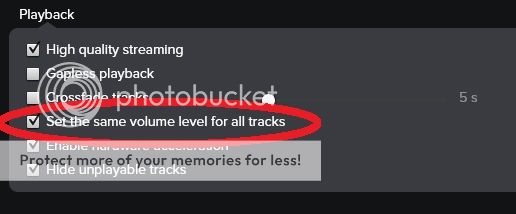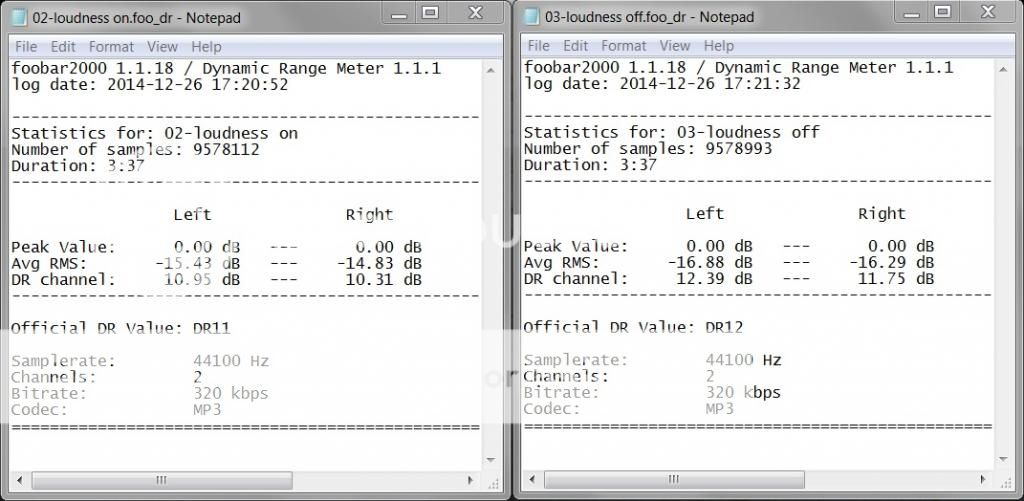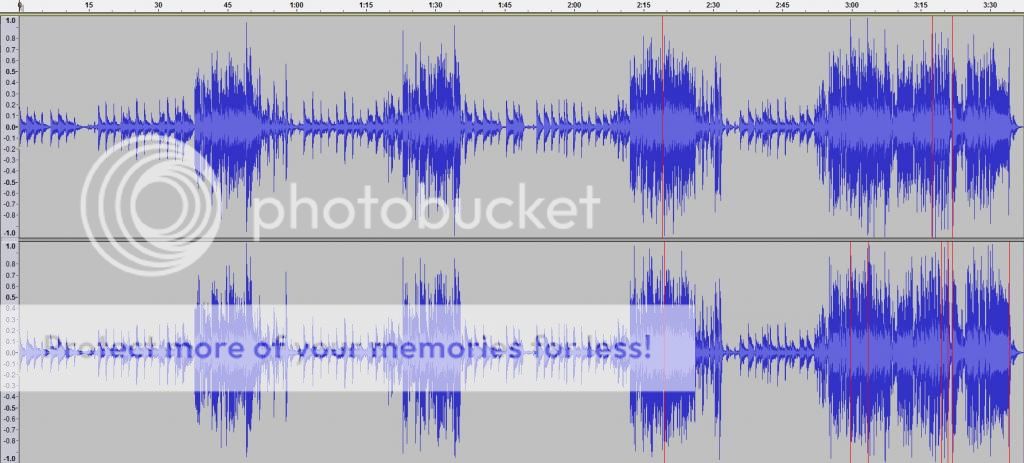steve_1979
pfm Member
Have you ever wondered what the 'Set the same volume level for all tracks' option in Spotify is really doing?
No probably not, but I have.

Googling didn't help to find an answer to this question because some people say that it works by normalization and others say that it works by reducing the dynamic range of the tracks that would originally have had a high dynamic range.
I hoped that it would only normalize* the volume to make all of the tracks seem equally loud. If this was done the full dynamic range (and thus the sound quality) of each track would be kept intact and it would simply balance the volume levels by reducing the volume of the tracks that have already had their dynamic range compressed.
So I decided to put it to the test myself by using the dynamic range meter in Foobar and comparing a track played via Spotify twice. Once with the 'Set the same volume level for all tracks' turned on and once with it turned off.
The one on the left is the result with it turned on and the one on the right is with it turned off.

A very disappointing result Spotify! They're reducing the dynamic range (and thus sound quality) of their music.
This may not seem like a big issue to most people but I think that Spotify have missed a chance here to put an end to the loudness wars once and for all. A bold statement you may think? Well think about it this way. Spotify and other streaming services have become the most popular way to listen to music right? Well, if they were to make all of the tracks play at the same volume by implementing normalization of the tracks this would allow their full dynamic range (and thus sound quality) to be kept intact.
All of the music would still play at the same average volume level like it already does. The only difference would be that the sound quality inadequacies of the dynamically compressed tracks would be obvious to hear when compared to music that has more dynamic range.
As we all know the loudness wars were started by record companies wanting their music to jump out at you by reducing its dynamic range to make it seem louder. However if everything was played at the same average volume by applying normalization this tactic would no longer work. Quite the opposite, they would now be motivated to make their music stand out by improving the sound quality instead by allowing music to be made with its full dynamic range still intact.
Spotify could still keep the existing dynamic range compression option available for people who want to use it because it can come in useful when listening to music in a loud environment. But they should also give a normalization option for people who want to listen to music that offers the best possible sound quality with a full dynamic range.
If enough people read this and spread the word to push Spotify (and other streaming services) to normalize the volume levels rather than dynamically compressing them we could put an end to the loudness war.
What do you think?
* http://en.wikipedia.org/wiki/Audio_normalization
No probably not, but I have.

Googling didn't help to find an answer to this question because some people say that it works by normalization and others say that it works by reducing the dynamic range of the tracks that would originally have had a high dynamic range.
I hoped that it would only normalize* the volume to make all of the tracks seem equally loud. If this was done the full dynamic range (and thus the sound quality) of each track would be kept intact and it would simply balance the volume levels by reducing the volume of the tracks that have already had their dynamic range compressed.
So I decided to put it to the test myself by using the dynamic range meter in Foobar and comparing a track played via Spotify twice. Once with the 'Set the same volume level for all tracks' turned on and once with it turned off.
The one on the left is the result with it turned on and the one on the right is with it turned off.

A very disappointing result Spotify! They're reducing the dynamic range (and thus sound quality) of their music.
This may not seem like a big issue to most people but I think that Spotify have missed a chance here to put an end to the loudness wars once and for all. A bold statement you may think? Well think about it this way. Spotify and other streaming services have become the most popular way to listen to music right? Well, if they were to make all of the tracks play at the same volume by implementing normalization of the tracks this would allow their full dynamic range (and thus sound quality) to be kept intact.
All of the music would still play at the same average volume level like it already does. The only difference would be that the sound quality inadequacies of the dynamically compressed tracks would be obvious to hear when compared to music that has more dynamic range.
As we all know the loudness wars were started by record companies wanting their music to jump out at you by reducing its dynamic range to make it seem louder. However if everything was played at the same average volume by applying normalization this tactic would no longer work. Quite the opposite, they would now be motivated to make their music stand out by improving the sound quality instead by allowing music to be made with its full dynamic range still intact.
Spotify could still keep the existing dynamic range compression option available for people who want to use it because it can come in useful when listening to music in a loud environment. But they should also give a normalization option for people who want to listen to music that offers the best possible sound quality with a full dynamic range.
If enough people read this and spread the word to push Spotify (and other streaming services) to normalize the volume levels rather than dynamically compressing them we could put an end to the loudness war.
What do you think?
* http://en.wikipedia.org/wiki/Audio_normalization



